1.4 Background of EVERLAND
1.1 Project Introduction
1.1.1 Market Background
In recent years, the emergence of cloud computing has given traditional IT infrastructure a new look. We have witnessed the dominance of centralized cloud computing, but decentralized models are also rapidly emerging, redefining the rules of the game in a freer, safer, and greener way. So what is the difference between centralized cloud computing and decentralized cloud computing? Let's take a look first:
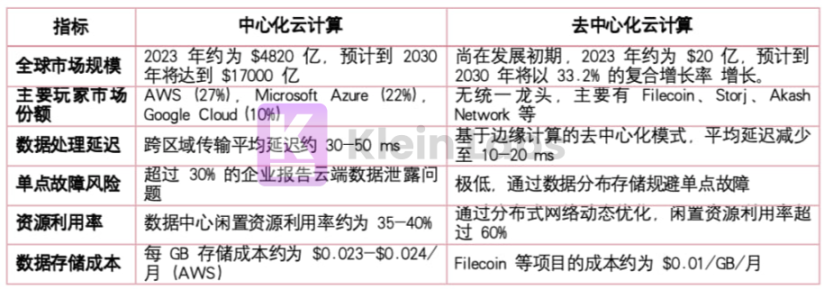
From the above, we can see that compared with the traditional centralized model, decentralized cloud computing is becoming the future development direction with its flexibility and privacy advantages. How special is decentralized cloud computing? No longer relying on a super server, data is spread across nodes around the world like water droplets. Capacity can be expanded at any time and allocated on demand. This flexibility makes it a far superior choice to traditional cloud computing.
In addition to this, there is growing concern about the environmental impact of cryptocurrency systems. Proof-of-Work (PoW) systems, in particular, end up consuming a lot of electricity and equipment. Data centers are expected to account for more than 3% of global carbon emissions by 2025. By 2040, digital data storage is expected to generate 14% of global carbon emissions, which is comparable to the current carbon emissions of the United States.
This is where DePIN (decentralized physical infrastructure network) comes in. DePIN covers multiple key areas, including network infrastructure, energy and sharing economy, edge computing and distributed computing power, decentralized storage, etc. Through blockchain and token incentives, DePIN turns decentralized resources into an efficient network. Helium's wireless network, DIMO's automotive Internet of Things, Grass's data capture platform, io.net's computing power platform - these projects have proven the potential of DePIN with practical actions.
In fact, the DePIN project has received a lot of investment in recent years, and fundraising has increased significantly. For example, from Q3 2023 to Q3 2024, the total amount of funds raised by the DePIN project has increased by nearly 7 times. In addition, in April last year, Binance also officially launched BNB Greenfield, which is an important milestone in the field of decentralized storage. Greenfield not only provides the core decentralized storage infrastructure for the BNB Chain ecosystem, but also pioneers the creation, storage and trading of completely autonomous data by users and decentralized applications (DApp).
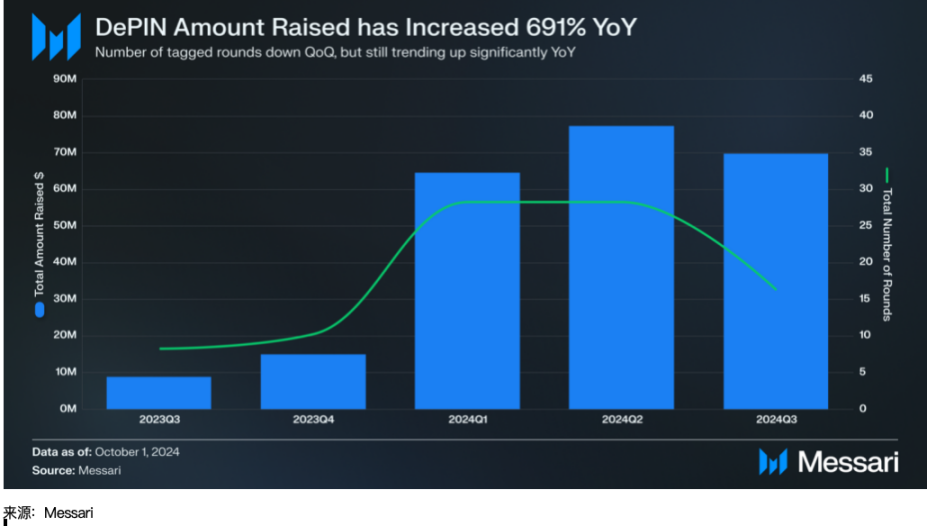
The entire DePIN industry currently has a market size of $90 billion, but 95% of its infrastructure capacity is not effectively utilized. In this trend, the hot project 4EVERLAND is a rising star. It is not only a decentralized cloud computing platform, but more like a resource aggregator for the entire DePIN track. Today we will talk about 4EVERLAND and how it solves this problem.
Unlike Filecoin (storage) or io.net (computing power), which only focus on a certain field, 4EVERLAND integrates a variety of DePIN technologies to "package" Web3's storage, computing, and network resources and provide them to customers on demand. For example, 4EVERLAND has established a close cooperative relationship with Arweave, a leader in the field of decentralized storage. Users can use Arweave's storage services efficiently and quickly through 4EVERLAND. For example, Snapshot (a well-known open source voting platform) uses 4EVERLAND's solution to store off-chain data on IPFS (a network transmission protocol designed to achieve distributed storage, sharing, and persistence of files) and Arweave (a decentralized storage network) to ensure the verifiability and persistence of data.
By integrating a decentralized physical infrastructure network and idle resources contributed by the community to provide efficient, secure and scalable cloud services, 4EVERLAND is moving step by step towards its vision: to become a bridge connecting Web2 and Web3, helping millions of Web3 applications and developers to smoothly transition to a decentralized architecture.
1.1.2 Establishment and development history
Founded in 2021, 4EVERLAND is headquartered in Singapore. Its investors include well-known BIXIN, FENBUSHI, FBG, Mint Ventures, Arweave, WaterDrip Capital, etc.
4EVERLAND is a new generation of decentralized cloud service platform that integrates storage, network and computing capabilities, and is committed to providing users with efficient, secure and scalable cloud computing services through innovative technical architecture and resource integration models. The architecture of 4EVER Network is positioned at the center of the DePIN ecosystem, aiming to efficiently integrate and utilize decentralized physical resources to provide infrastructure for millions of Web3 developers and applications.
As a groundbreaking technology, its strategic focus includes two directions: one is to maximize the efficiency of resource utilization through deep integration of the existing DePIN protocol; the other is to achieve the goal of significantly reducing operating costs by connecting idle physical resources around the world. By combining these two strategies, 4EVERLAND is committed to building a decentralized cloud infrastructure for developers and enterprises that is both efficient and resilient, and promotes a new era of sustainable cloud computing.
Moreover, 4EVERLAND is not fighting alone. As an important supporter of BNB Greenfield, it is deeply integrated into the ecosystem of BNB Chain and has become a key player in Messari's DePIN map. Compared with fighting alone, it is more like an "infrastructure maniac" in the DePIN ecosystem, helping global developers to smoothly transition from Web2 to Web3, and setting off a decentralized revolution in cloud computing.
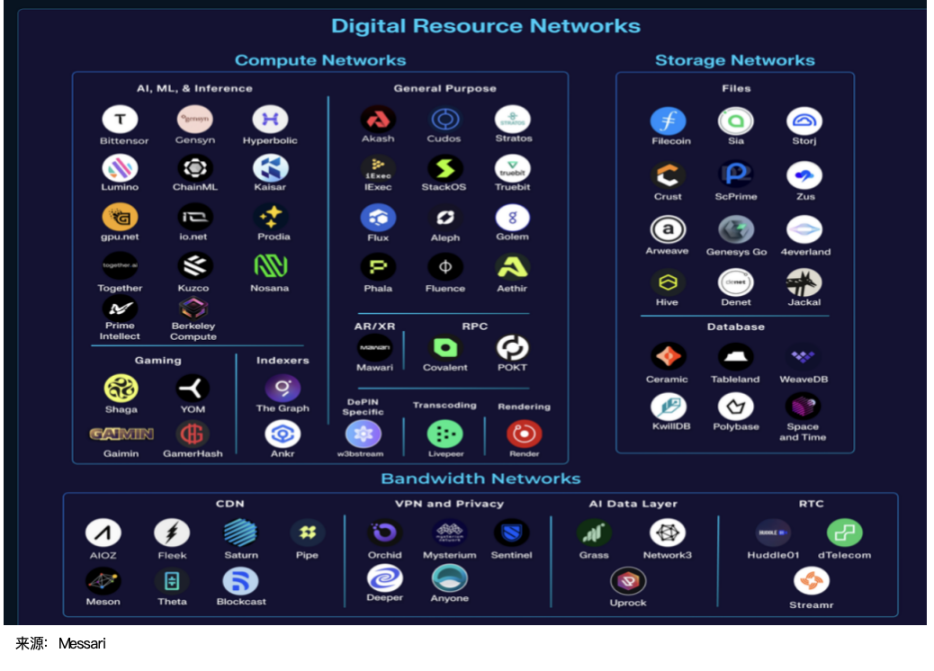
1.1.3 Important time points

1.2 Data Overview
1.2.1 Project Data
Since the launch of the 4EVERLAND mainnet, its development momentum has been rapid. The platform has accumulated more than 3 million registered users, including more than 100,000 daily active users (DAU) and more than 1 million monthly active users (MAU), covering more than 250,000 developers and customers. These data show that 4EVERLAND has quickly attracted widespread attention from developers and enterprises around the world in a short period of time. Combined with the data from the past week, 4EVERLAND's independent active wallets (UAW), transaction volume and other performances have shown a strong growth trend.
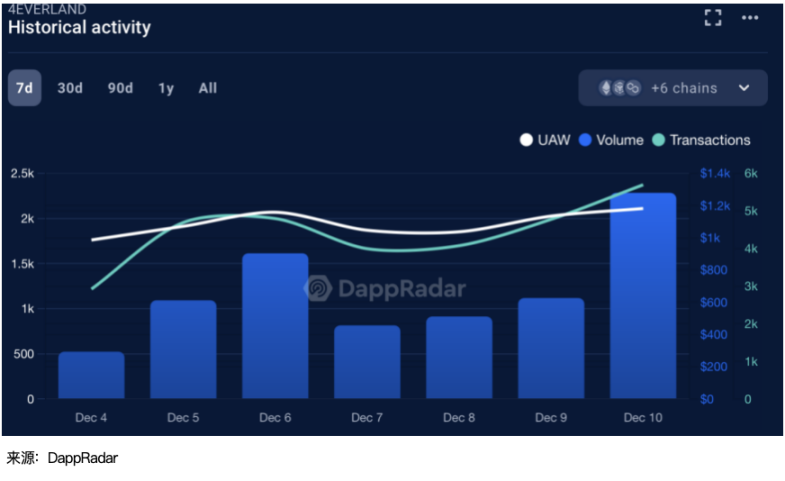
In the field of storage, 4EVERLAND occupies an important position in the decentralized storage market and has become a leader in multiple storage ecosystems:
- BNB Greenfield: BNB Greenfield is the third chain in the BNB ecosystem, a public chain focusing on decentralized storage. 4EVERLAND is the largest decentralized storage provider in the Greenfield ecosystem, and is also an officially certified storage provider (SP) and validator. As the core pillar of Greenfield, 4EVERLAND not only provides it with powerful storage resources, but also supports BNB Chain and opBNB networks. By integrating the advantages of IPFS and Arweave, 4EVERLAND provides a more efficient and user-friendly storage solution, greatly reducing the threshold for users to use decentralized storage. As its first unofficial storage provider and validator, 4EVERLAND ranks first in the ecosystem with 30,000 storage transactions per day. The storage transaction volume in the past 7 days has achieved a growth rate of 180%, far ahead of other competitors.
- IPFS storage: The cumulative storage capacity reaches 2,000 TB, ranking third in the IPFS ecosystem.
- Arweave Storage: Achieves 20 TB of storage, also ranking third in the Arweave ecosystem.
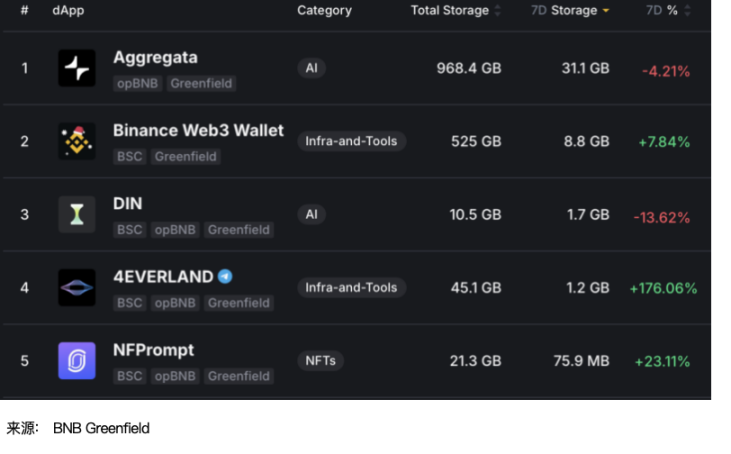
In the Arweave ecosystem, 4EVERLAND is also a top storage provider.
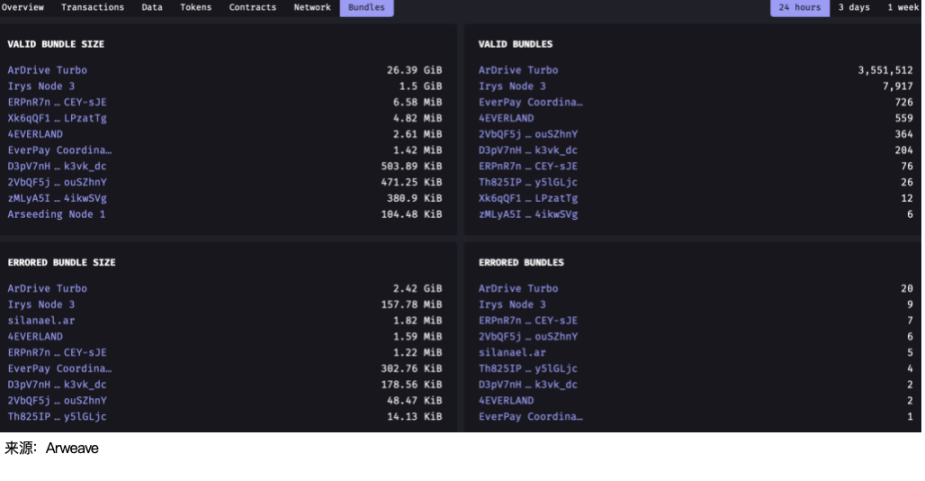
In terms of core competitiveness in serving global customers, 4EVERLAND has provided storage and computing services for more than 250,000 applications, including Snapshot (the only IPFS + Arweave storage and gateway provider), Taiko, PumpFun, Linear Finance, RSS3 and other well-known projects. In particular, with its support for Snapshot.org, 4EVERLAND has surpassed rivals such as Fleek and Pinata with a performance advantage of up to 99.9%, becoming the preferred storage solution for developers and teams. In addition, it has also received grants from BNBChain, Polygon, Optimism, IPFS, Arweave and ICP.
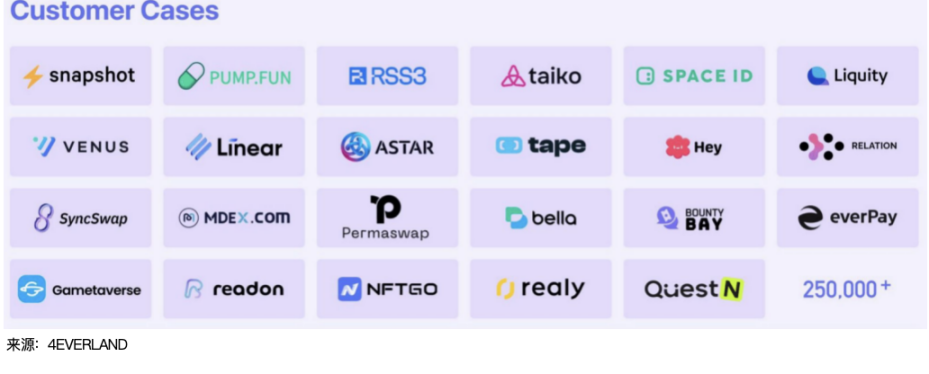
In terms of ecosystem support and wallet compatibility, 4EVERLAND is compatible with 10+ mainstream Web3 wallets, such as MetaMask, OKX Wallet, Binance Web3 Wallet and Coinbase Wallet, providing users and developers with convenient access methods and a wider range of application scenarios. This diverse support further consolidates its core position in the Web3 ecosystem.
1.2.2 Social Media Data
4EVERLAND has shown high activity in different media channels, as shown below:
- Telegram Group: This community has more than 950,000 members, and the number of active users has reached more than 30,000
- X: Over 360,000 followers, with frequent updates.
- Discord: This platform has over 75k members and over 2k active members.
- Telegram miniapp: This channel has over 1 million users per month.
In addition, there are 30,000+ interactions on its Github every day (the data is triggered by users linking the host to Github, which to a certain extent represents the frequency of project updates).
1.3 Token Economics
4EVERLAND's economic model has been carefully designed, and its economic ecosystem adopts a unique dual-token economic model: $4EVER is 4EVERLAND's core governance token, while $LAND is 4EVERLAND's resource token. It aims to ensure the stability and security of the network while implementing a sustainable dynamic incentive mechanism.
1.3.1 $LAND: Stablecoin and Resource Payment Unit
$LAND was launched to provide users with a stable and efficient resource payment system in the 4EVERLAND ecosystem. As a stable token, it serves as the main settlement tool for all user services.
- Stable value anchoring: $LAND uses a fixed exchange rate (1 USD = 1 million $LAND) as a settlement tool for resource payments, effectively avoiding volatility risks.
- Resource Payment: $LAND is used to measure and account for all resource consumption on the 4EVERLAND platform, such as bandwidth, build time, compute units, API calls, and node usage.
- Flexible exchange mechanism: supports the conversion of multiple blockchain assets into $LAND. The corresponding assets will be automatically converted into stablecoins and deposited into the Treasury smart contract.
- Treasury circulation: Assets deposited in the treasury are converted into stablecoins and distributed in two main ways:
-- Ecosystem Rewards: Used for 4EVER repurchase and distributed as rewards to resource providers and 4EVER holders.
-- Token Buyback and Burn: Increase the scarcity of 4EVER, thereby increasing its value.
- Non-liquidity: $LAND is only used for resource payment within the 4EVERLAND ecosystem and cannot be traded on the secondary market to ensure value stability.
1.3.2 $4EVER: Governance and Utility Tokens
As the governance and utility token of 4EVERLAND, 4EVER is the core carrier of ecosystem value, solving various use cases from resource payment to value capture and decentralized governance. It plays a vital role in driving the long-term sustainability of the system. $4EVER’s functions and roles:
- Node Staking and Rewards: 4EVER powers the PoS mechanism and the AVS mechanism. Resource providers must stake $4EVER to participate in node elections and receive $4EVER as a reward for their contribution.
- Value Acquisition and Buyback Mechanism: The platform’s revenue recovery mechanism enables $4EVER to acquire value from the treasury pool, increasing the scarcity and value of $4EVER through the buyback and burning process.
- Resource Payment: Users can choose to exchange $4EVER for $LAND and use $LAND to pay for services, thereby driving the circulation and demand of tokens.
- Ecosystem Governance: As a governance token, $4EVER empowers holders to participate in key decision-making processes, such as proposing and voting on platform upgrades, resource allocation, and shaping the future of the ecosystem.
The total amount of $4EVER is 10 billion, of which 70% will be used to support 4EVER node rewards, community development and operation, and user incentives to promote the prosperity and development of the decentralized cloud computing ecosystem. The specific distribution ratio is: 40% for node rewards, 15% for community funds, 10% for operating funds, 5% for user rewards, and the rest includes 15% for token sales, 12% for the core team and consultants, and 3% for initial liquidity and market making funds.
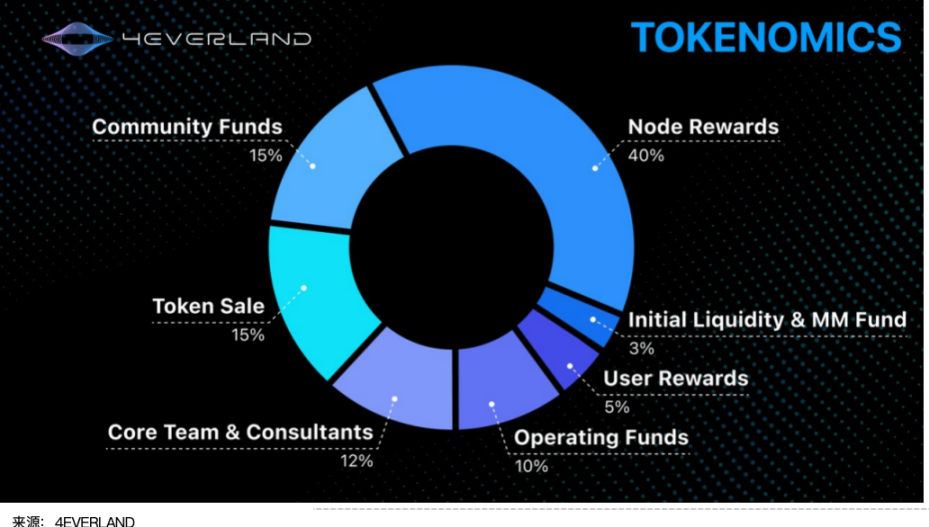
Essentially, 4EVER is the cornerstone of the functionality and value capture of the 4EVERLAND ecosystem. It not only supports the daily operational needs of the platform, but also improves transparency and fairness through a decentralized governance system. As the platform continues to expand, 4EVER will increasingly serve a wider audience, including node operators, developers, and community participants. Just on December 12, $4EVER was officially launched on three major exchanges including Gate.
1.4 Technical Architecture Principles
4EVER Network is a decentralized ecosystem that acts like a “resource magician” that can dynamically allocate resources globally, allowing developers and users to enjoy a seamless and reliable service experience.
Its "secret weapon" is the 4EVER DePIN aggregator, a powerful tool that is like a master key to cloud services, integrating decentralized infrastructure in different fields. For example, IPFS and Arweave are integrated in storage, Akash and IO.net are used in computing resources, and Fleek and Cloudflare are introduced in network services. This "puzzle-like" design of combining powerful forces allows developers and users to freely choose from these resources and select the most suitable service for themselves like a buffet.
Resource providers are the unsung heroes of this ecosystem. They contribute their computing, storage or network capabilities to the system by running specific integrated programs. The 4EVER protocol is like a "scheduling master", assigning tasks according to user needs, allowing resource providers to complete their work efficiently and receive rewards. The 4EVER node provides an easy way for the community to participate, allowing everyone to support network operations by contributing idle resources.
In order to ensure that all resources operate efficiently and safely, the 4EVER protocol plays the role of "rule keeper". It uses the Proof of Stake (PoS) mechanism to verify the credibility of resource providers, and at the same time ensures the healthy operation of the network through token staking, reward and penalty mechanisms. Finally, the 4EVER protocol integrates and virtualizes all resources through a series of modules, providing developers with a one-stop interface to easily meet diverse needs.
To put it in the simplest metaphor, 4EVER Network is like an intelligent, decentralized "super cloud service provider" that is not only efficient and flexible, but also brings privacy and elasticity that are difficult to achieve with traditional cloud computing.
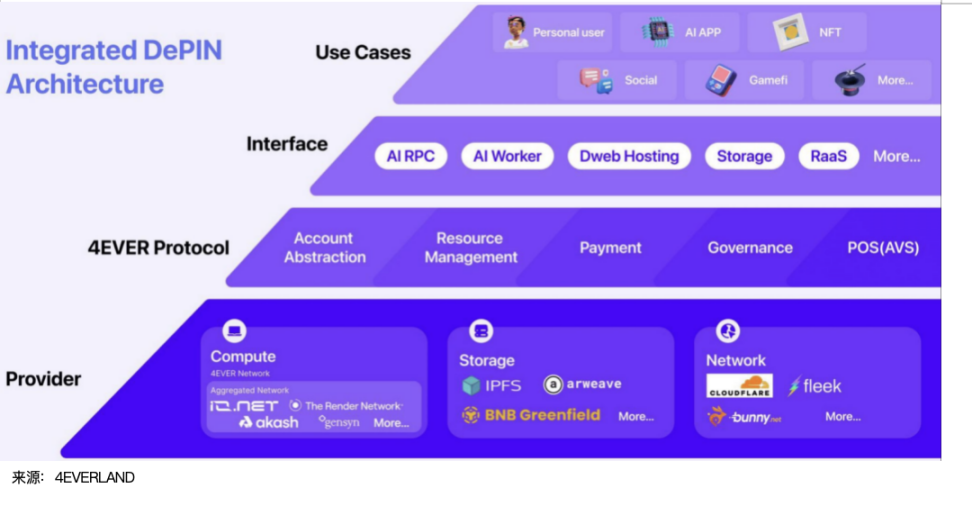
Let’s take a look at what changes 4EVER Network has brought to developers.
1.4.1 Computing Providers
For developers who need computing resources, 4EVER Network is like a "CPU and GPU supermarket". It integrates platforms such as Akash, IO.net and Render Network, and can provide underlying high-performance computing resources. From machine learning model training to virtual reality content creation, to video encoding and graphics rendering, these needs can be met. This means that developers can easily obtain flexible computing power and no longer worry about hardware limitations, so as to quickly complete more complex projects and create more efficient applications.
1.4.2 Storage Provider
In terms of data storage, 4EVER Network is the "ambassador of distributed storage". By integrating technologies such as IPFS, Arweave and BNB Greenfield, it can provide developers with efficient and stable storage services. These decentralized storage methods avoid the single point of failure common in traditional centralized systems while supporting fast data retrieval, which is particularly suitable for scientific research, content distribution networks (CDN) and blockchain applications that need to process big data. Whether developers want to store Internet archives or massive media content, they can find efficient solutions.
1.4.3 Network Provider
In terms of network connection, 4EVER Network is a "highway builder". It provides stable connection and fast data transmission for applications in the network through platforms such as Fleek, Meson Network and Saturn. Whether it is real-time video conferencing, online games or IoT device management, this high-performance network can ensure smooth data transmission. Developers' users can also enjoy low-latency, high-quality services.
1.4.44EVER Node
4EVER nodes are like a "resource crowdfunding platform" that integrates unused local hardware resources in the community. Unlike the DePIN protocol, 4EVER nodes directly virtualize users' computing, storage, and network resources and add them to the entire network. This innovative model not only improves resource utilization, but also encourages more community members to participate in platform construction by sharing idle equipment, ultimately bringing greater flexibility and stability to the network.
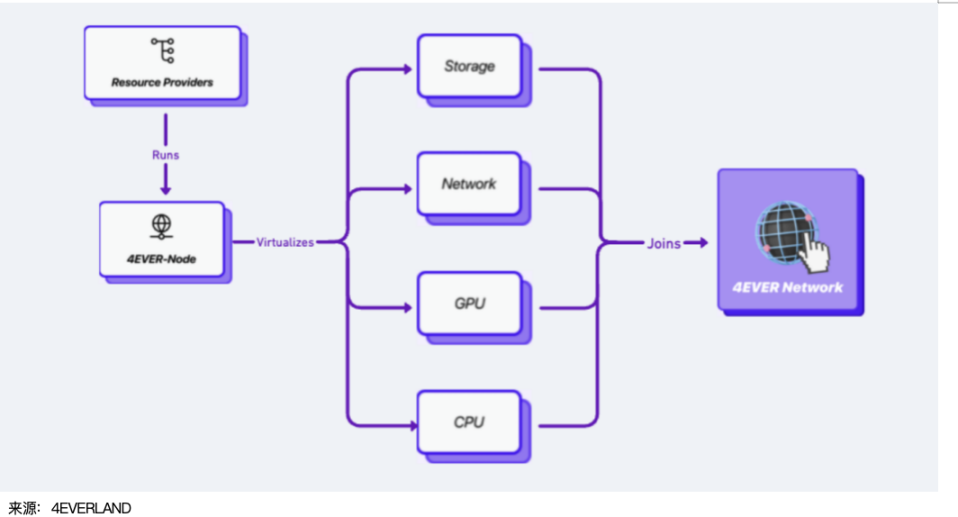
1.5 Competitors
1.5.1 Filecoin
Filecoin is a decentralized network that allows users to store and retrieve data. It was developed by Protocol Labs and is dedicated to providing storage services for the Web3 world. Compared with traditional cloud storage (such as AWS or Google Drive), Filecoin uses blockchain technology to achieve decentralized data storage. Users can choose to have miners (storage providers) store data in a distributed manner, avoiding data security risks that may be caused by a single service provider.
The Filecoin mainnet was officially launched in October 2020. In 2023, Filecoin launched its own virtual machine (similar to Ethereum's EVM), allowing developers to deploy and run smart contracts. This opens new doors for Filecoin's application ecosystem, such as decentralized markets, data transactions, etc. Filecoin has now become a benchmark application for data storage in the Web3 field, not only storing users' personal files, but also supporting important content such as Wikipedia's historical archives and biological research data.
Filecoin and 4EVERland each have their own unique positioning. Filecoin is the leader in the decentralized storage field, with mature technology and a wide range of applications, but it focuses more on storage services. 4EVERland integrates computing and network services on the basis of storage, which is more flexible and suitable for users who need multi-functional solutions.
1.5.2Storj
The story of Storj began in 2014, when founder Shawn Wilkinson proposed a vision of a more secure and economical cloud storage: by utilizing the world's excess hard drive space, circumventing the high costs and potential security issues of traditional cloud storage (such as AWS). In 2017, Storj raised $30 million through an initial coin offering (ICO), laying the foundation for its technology and operations. Then in 2018, Storj officially launched its service, which is operated by Storj Labs.
Storj introduced the bridge protocol in 2020, strengthening its interoperability with Ethereum and other blockchains. This update significantly improved the liquidity and utility of the Storj token (STORJ), providing users with more payment and transaction options. In addition, Storj uses core technologies such as Reed-Solomon redundant storage encoding to ensure that data is highly available even when some nodes are offline, while supporting rapid data repair. Data uploaded to the Storj network will be encrypted, and only users with the key can decrypt and access it, fundamentally protecting privacy.
Similar to Filcoin, Storj is also mainly innovative in distributed storage solutions and has a different market positioning from 4everland.
1.5.3 Akash Network
Akash was founded in March 2018 by Overclock Labs, a software development company founded by Greg Osuri and Adam Bozanich. Initially, Overclock Labs focused on building a traditional multi-cloud deployment platform, but as the project progressed, the team saw the huge potential of decentralized cloud computing and eventually decided to launch Akash Network to realize the vision of a distributed cloud computing market.
Akash Network is developed based on the Tendermint consensus protocol and Cosmos SDK, with cross-chain interoperability and seamless integration with other blockchain ecosystems. Its core innovation is the introduction of a decentralized computing market where users can bid for idle computing resources, and node operators who provide resources are rewarded by completing tasks.
Compared with traditional cloud service providers such as AWS and Google Cloud, Akash's service costs are significantly lower, and the fees are usually only 1/2 to 1/3 of traditional services. This not only benefits small developers and start-ups, but also provides users with higher data privacy protection. Users can complete computing task deployment without disclosing identity information, and the execution and cost of tasks are completely transparent. According to official website data, Akash Network currently integrates 638 GPUs, and the utilization rate has reached 80%.
1.5.4IO.net
io.net is a decentralized GPU allocation infrastructure on the Solana network, which originated from the team's deep need for high-performance computing. When the team was deploying high-frequency trading (HFT) algorithms, due to the expensive and resource-constrained NVIDIA graphics cards, they realized that they needed a more cost-effective and more available computing resource platform. This demand became the inspiration for the io.net project. The team changed its name from Antbit to io.net, and gradually transformed from initially developing institutional-grade quantitative trading systems to focusing on the construction of a decentralized computing resource market, especially for ML) and AI model developers.
io.net was founded and led in 2018 by Ahmad Shadid, a former quantitative system engineer at WhalesTrader and Arabfolio and a contributor to the Ethereum Foundation. After Ahmad stepped down in June 2024, co-founder and former COO Tory Green took over as CEO. Tory Green graduated from Stanford University and has extensive operational management experience. He served as COO of Tiller Partners and HUM Capital.
Akash Network and io.net focus more on GPU computing power calls. Compared with them, 4everland can call more types of cloud resources, and the public chains they are located on are also different.
We compare and contrast the main features of these platforms in the following summary:
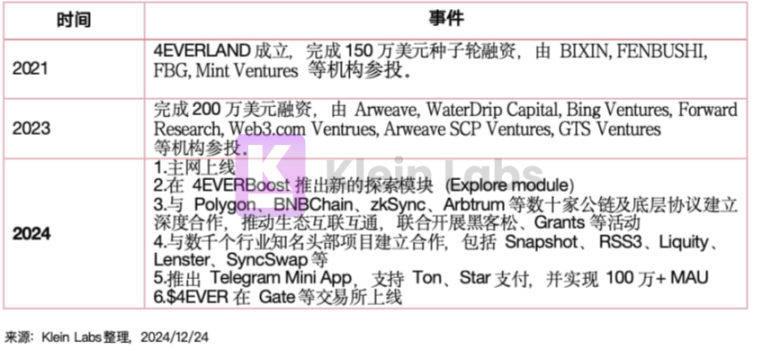
2.4 EVERLAND Ecosystem
4EVERLAND’s success is inseparable from its extensive ecological cooperation. In less than four years, 4EVERLAND’s ecological construction has made significant progress, including in-depth collaboration with many decentralized protocols and blockchain projects, including but not limited to the following leaders:
- Blockchain infrastructure: BNB Chain, Polygon, Arbitrum, zkSync, Solana, etc.
- Decentralized storage: BNB greenfield, IPFS, Arweave, Dfinity;
- Web3 applications: Snapshot Labs, Mdex, etc.
- DeFi: Uniswap, SushiSwap, Linear Finance, Venus Protocol, etc.
These partners (50+ core partners) provide a solid foundation for 4EVERLAND to support diverse user scenarios. At the same time, thousands of ecosystem partners also inject strong momentum into its ecological development.
In addition, DApps deployed on 4EVERLAND cover various industries, including DeFi, Game, RaaS, NFTs, Socialfi, etc.

2.1DEFI Track
4EVERLAND provides IPFS front-end gateway support for many well-known DeFi protocols. By deploying the front-end to a distributed storage network, it not only improves the anti-censorship capabilities of the front-end deployment, but also solves the potential access restrictions and single point failure problems faced by traditional centralized deployment. At the same time, with the help of 4EVERLAND's distributed gateway technology, it significantly improves the loading efficiency and access stability of global users.
4EVERLAND's support has become an important boost to improving infrastructure capabilities in the DeFi field, providing technical support for more decentralized protocols and promoting the continued development of the Web3 ecosystem.
2.2GAMEFI Track
In the Gamefi field, 4EVERLAND provides storage and hosting services for Web3 games. There are many game projects in the 4EVERLAND ecosystem, only some examples:
2.2.1 Owlando
Project Overview: Owlando is an innovative cross-platform UGC social game metaverse. In today's gaming ecosystem, users' creativity is often not recognized and encouraged. Owlando opposes this norm. Its platform integrates non-fungible tokens (NFTs) to protect users' in-game creations and monetizes them to incentivize gamers to build and share their ideas. This process forms a positive-sum game, where the platform accumulates rich content, while players can express their creativity and benefit directly. Owlando won third place in the Web3 Innovation Competition organized by BeWater.
X: @Owlando_OFCL
2.2.2 Tabi
Project Overview: Tabi (formerly known as Treasureland) is a BNB chain-based platform that enables users to trade NFTs and participate in launchpads. It also converts on-chain activities into "experience points" that can be used to earn future airdrop rewards. The platform includes a gaming platform that aggregates blockchain game transactions and entertainment. Investors include: Hashkey Capital, YouBi Capital, etc.
X: @Tabichain
2.3 Other ecological cooperation cases
2.3.1 Snapshot
Snapshot is a voting platform widely used in decentralized autonomous organizations (DAOs) that relies on secure and efficient storage solutions to save proposals and voting records. 4EVERLAND provides storage services for Snapshot, achieving the following advantages:
- Simplified development process: 4EVERLAND is compatible with the AWS S3 API, allowing the Snapshot team to quickly integrate its storage service without complex development work.
- Multi-protocol support: Through a unified API, 4EVERLAND supports both IPFS and Arweave storage protocols, providing flexible decentralized storage options to meet Snapshot's needs for data persistence and accessibility.
- Efficient storage performance: 4EVERLAND provides efficient, low-latency storage services with an average response time of less than 100 milliseconds, ensuring that Snapshot users have a smooth experience during voting and proposal processes.
- Data integrity and long-term preservation: By leveraging the content addressing features of IPFS and the permanent storage features of Arweave, 4EVERLAND ensures the integrity and long-term preservation of Snapshot data, enhancing the reliability of the platform.
2.3.2 RSS3
RSS3 is a decentralized content and social protocol dedicated to building a transparent, decentralized and modular ecosystem. By using 4EVERLAND as its IPFS provider, RSS3 is able to achieve:
- Decentralized storage: Utilize 4EVERLAND's IPFS service to ensure decentralized storage and access to data.
- Ecosystem integration: The cooperation with 4EVERLAND reflects the practice of decentralization and modularization.
- This partnership demonstrates 4EVERLAND’s capabilities in supporting decentralized applications and services
2.3.3 Liquity
Liquity is a decentralized lending protocol that allows users to borrow stablecoin LUSD using Ethereum as collateral. To ensure the high availability and censorship resistance of its front-end, Liquity has partnered with 4EVERLAND to deploy its front-end on a decentralized network. Through 4EVERLAND's global acceleration and distributed storage, Liquity's users can quickly and securely access its services in different regions.
2.3.4 Lenster
Lenster is a decentralized social media platform built on Lens Protocol, which aims to provide users with privacy protection and data sovereignty. To achieve distributed storage and management of its data, Lenster integrates 4EVERLAND's decentralized storage service Bucket to store application data on the IPFS network.
Through 4EVERLAND's globally distributed IPFS nodes, Lenster's data achieves high availability and global acceleration capabilities. In addition, 4EVERLAND also serves as Lenster's IPFS fixed service provider to ensure data persistence and reliability. This cooperation enables Lenster to provide users with a more stable and efficient decentralized social experience.
2.3.5 SyncSwap
SyncSwap is a decentralized exchange built on zkSync, providing fast and low-cost trading services. The collaboration between 4EVERLAND and SyncSwap aims to achieve decentralized front-end hosting and enhance the development of SyncSwap in the zkSync ecosystem. By adopting 4EVERLAND Hosting, SyncSwap is able to deploy its front-end on decentralized storage networks such as IPFS, Arweave, and ICP. This deployment method ensures high availability and censorship resistance of the front-end, improving user experience and system security. In addition, the automated build and deployment tools provided by 4EVERLAND enable the SyncSwap team to manage and update its front-end applications more efficiently. This collaboration demonstrates the potential of decentralized technology in real-world applications and provides a valuable reference for other blockchain projects.
3. Summary of highlights
Decentralized storage technology has gone through multiple iterations and innovation stages, from the earliest Storj to the later Filecoin, Arweave, and the IPFS protocol that supports its operation. Despite this, centralized storage still occupies most of the market share with its mature product system and smooth user experience. Decentralized solutions such as Filecoin and Arweave face their own limitations: Filecoin's programmability still needs to be enhanced, and its permanent data storage capacity is restricted; Arweave focuses on the concept of "permanent storage", but its relatively high cost has hindered its popularization.
Similar challenges also exist in the field of decentralized cloud computing. The first is scalability. Due to the dispersion of computing resources, it is difficult to cope with high concurrency and large-scale computing needs. The second is the cost issue. Although decentralization can reduce infrastructure costs, the complexity of node distribution and resource scheduling increases operating costs. At the same time, latency and performance optimization are also challenges.
These issues highlight the current shortcomings of the industry, while also providing important directional guidance for technology optimization and model innovation. 4EVERLAND integrates the core capabilities of storage, computing, and networking through decentralized front-end hosting, decentralized storage, global acceleration gateways and other services, providing efficient and reliable computing solutions. With its unique architectural design and deep optimization of developer experience, 4EVERLAND demonstrates characteristics that are completely different from other platforms in the market. As a distributed cloud platform focusing on Web3 services, 4EVERLAND's strategic layout and technical implementation not only emphasize the core spirit of decentralization, but also cleverly balance user experience and cost-effectiveness. Here are some of our core views:
1. Break through the new paradigm of all-round services with single functions
The advantage of 4EVERLAND is that it is not only a technical service, but also builds an all-round distributed cloud ecosystem. Its service range ranges from storage to computing, covering the entire life cycle of developers building DApps.
Platforms such as io.net and Akash mainly focus on decentralized computing capabilities in a single field and perform well in the DePIN market, but they usually lack comprehensive functions such as storage and network acceleration, and the construction of their own standards makes the user experience relatively complicated. In contrast, single storage services such as Filecoin and Arweave, although they have an advantage in the field of decentralized storage, cannot provide comprehensive cloud service support. 4EVERLAND, on the other hand, integrates computing, storage, and network acceleration to create a distributed AWS similar to Web3. Its unified API design allows developers to quickly deploy projects without having to master the underlying blockchain technology, thus surpassing it in terms of user-friendliness and comprehensive functionality.
2. Double breakthrough in technology implementation and user experience
Compared to Akash's emphasis on the efficiency of the computing power bidding market or io.net's GPU time lock proof, 4EVERLAND focuses more on the optimization of the entire chain from technology to user experience. 4EVERLAND's interface design and deployment tools focus on lowering the threshold, allowing users with non-technical backgrounds to easily deploy distributed applications. This design that is close to user needs makes it the first choice for Web3 startup teams and individual developers. In addition, it also focuses on the balance between performance and economy: through distributed CDN networks and intelligent routing, 4EVERLAND provides a performance experience close to traditional cloud services, but significantly reduces costs. This extreme optimization is extremely rare in decentralized platforms.
3. Implementation of user privacy and data autonomy
The core value of decentralized technology lies in data sovereignty, and 4EVERLAND's practice of this is exemplary. Users not only own their data, but also can ensure that data is distributed globally and protected from centralized attacks through a decentralized architecture. Compared with io.net's on-time rental model, 4EVERLAND's shard storage solution shows unique highlights in data integrity and availability.
In addition, 4EVERLAND adheres to the design concept of privacy first. 4EVERLAND's KYC-free mechanism and fully transparent fee management system allow users to use services in a completely anonymous environment, which is particularly important for privacy-sensitive industries such as finance and healthcare.
4. Innovative integration of incentive model and community governance
Value capture of token economy: 4EVERLAND emphasizes the versatility of tokens, and its carefully constructed dual-token economy achieves a sustainable balance between growth and stability. We believe that 4EVER will become an important bridge to the future decentralized Internet, enabling developers, users, and community participants to collaborate to build a prosperous and scalable Web3 ecosystem.
5. Global layout and high adaptability
4EVERLAND has deployed distributed nodes around the world to provide users with high-speed and stable content delivery services. Its intelligent node routing technology improves performance while reducing network latency. It also has future-oriented expansion capabilities: 4EVERLAND's technology stack is more adapted to the long-term development needs of the Web3 world, including future applications such as decentralized domain names and on-chain storage.
With the rapid development of the decentralized storage field, the synergy of 4EVERLAND is driving the construction of a new generation of Web3 infrastructure. Its deep integration, multi-chain support, and user-friendly design not only expand the application scenarios of decentralized storage, but also inject strong innovation momentum into the entire ecosystem. However, this field is still full of unknowns. In the future, can decentralized storage completely replace centralized solutions? How does the market balance the relationship between user experience, cost, and privacy? Will the competition in the ecosystem intensify, or will greater synergies be achieved through cooperation? These questions still need to be explored and answered by the industry.
In this ever-changing field, 4EVERLAND's continuous technological iteration and ecological expansion will undoubtedly set more benchmarks for the industry and provide a strong reference direction for other projects. And this game about data autonomy and the future of storage may have just begun.
4. References
1.https://dappradar.com/dapp/4everland?range-ha=7d&range-ds=7d
2.https://docs.4everland.org/depin/4ever-network
3.https://viewblock.io/arweave/topStats?tab=bundles
4.https://messari.io/copilot/share/latest-developments-in-depin-fc2b1081-6657-420e-a99b-ab5386eac9d2
5.https://www.storj.io/blog/a-new-milestone-in-storjs-journey
6.https://www.storj.io/blog/the-green-case-for-storj
7.https://akash.network/pricing/gpus/
8. https://stats.akash.network
9.https://messari.io/project/akash-network-2/profile
10.https://www.coingecko.com/learn/what-is-io-net-io-token
11. https://medium.com/4everland/4everland-tokenomics-establishing-the-foundational-value-pillar-for-global-web3-computing-dc097f1918ea












